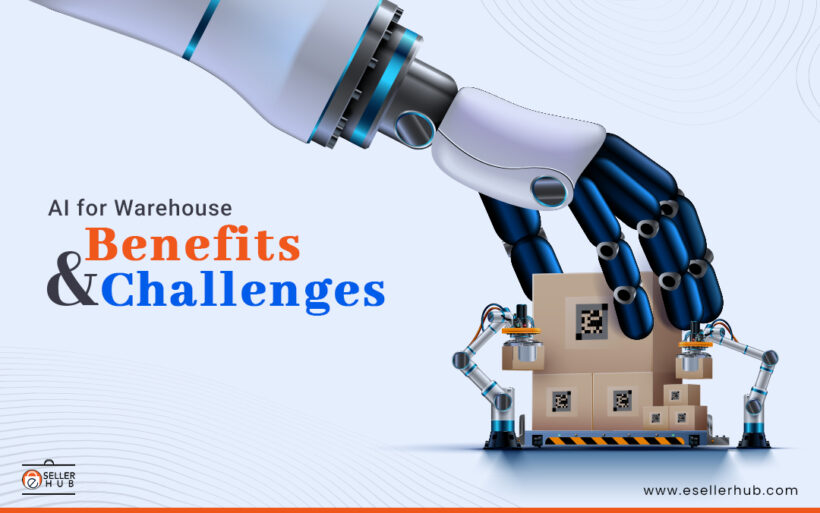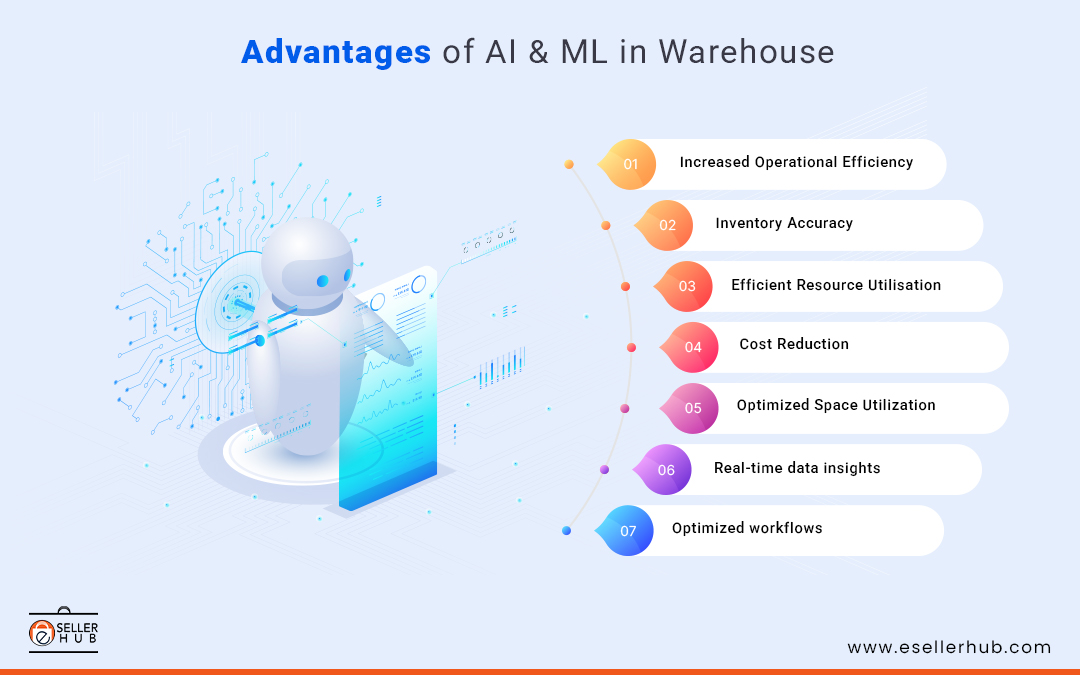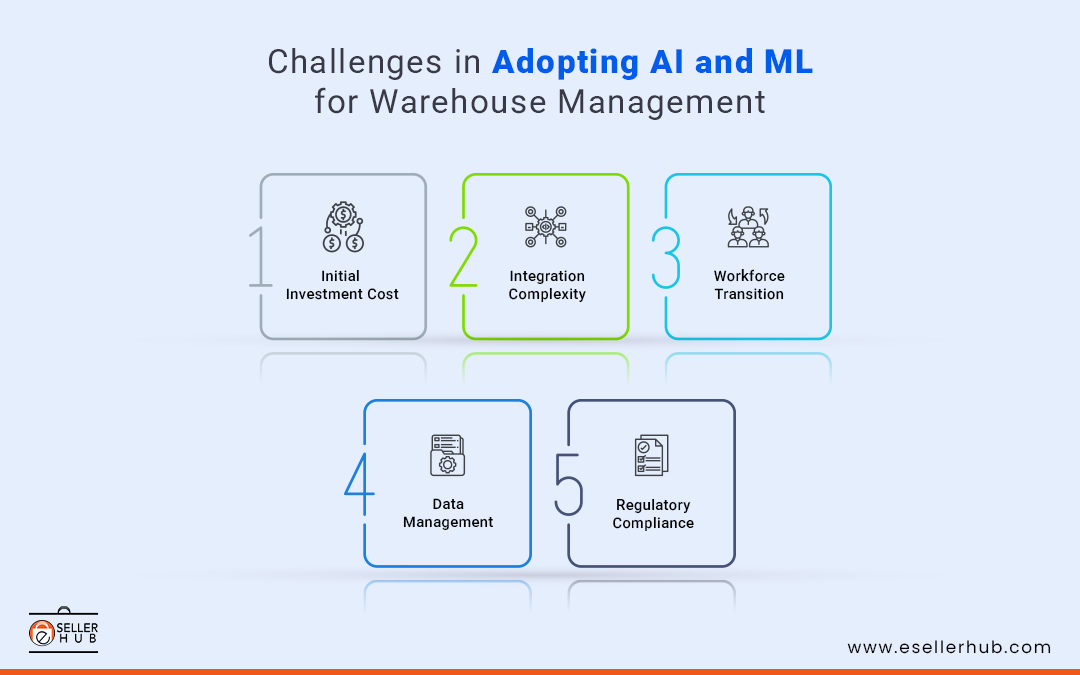Latest Posts
AI-ML in Warehouse Management: Benefits, Implementation Challenges & Process

In continuation with the previous blog, we have understood how AI and ML are contributing to the improved efficiency of warehouse management and advancing internal warehouse operations. These high-tech technologies are excelling in true senses to transform the warehousing industry in many ways.
The growing adoption of AI in warehousing shows no sign of easing off as it has become an inextricable factor for growth. AI-driven warehousing witnesses automated tasks, reduced process delays, streamlined workflow, cost efficiency, and more. Around 6 out of 10 warehouse management businesses or sellers incorporate AI in their internal operations.
We have understood AI & ML in warehouse management, what challenges these technologies resolve, and the core areas where AI-ML algorithms can be applied.
In this blog, we discuss the major benefits and reasons for businesses to adopt AI & ML within warehouse management, and what challenges they might face to seamless implementation of an AI-enabled warehouse management software solution.
Benefits of AI & ML in the Warehousing Industry
Warehouse management is itself a complex ecosystem, with an array of challenging tasks with no space for error. When a business or sellers deal with the orders of thousands of products daily, the error likelihood increases. An AI-powered WMS offers a new state of perfection for warehouse management with real-time visibility into processes, precise location tracking, and more.
Let’s explore some of the core benefits of AI adoption within the warehouse industry.

Increased Operational Efficiency
A warehouse not only combines extensive products but an array of complex operations as well. AI & ML help in optimizing frequent warehouse operations including automated tasks, vehicle routing, task allocation, and more based on past data and inventory details.
Such dynamic level optimization enables warehouses to maximize productivity with reduced downtime and inefficiencies.
Inventory Accuracy
A warehouse deals with a huge number of SKUs at once and managing such large inventory along with multiple orders can be a tiresome deal. AI-powered computer vision systems add accuracy to inventory management with automatic shelve scans, identifying discrepancies between inventory records and more.
This ensures that businesses have clarity with their inventory stock levels, eliminating the hassles of manual audits, and unrequired errors.
Efficient Resource Utilisation
AI tracks down everything from task allocation to completion and any midway roadblocks. As can identify idle resources and assign tasks accordingly for efficient resource utilization.
Most of the tasks are automated from order processing to packing and shipping, freeing up resources for focused tasks. This helps increase warehouse productivity by up to 49% by automating repetitive and time-consuming activities.
Cost Reduction
Most of the processes are automated, lowering the requirements of the manual labor. Also with the AI-driven WMS, there are very less chances of any errors that can lead to inventory accuracy, damage, or cause product return. Constant warehouse process optimization eliminates the possibility of human errors and associated unnecessary costs.
Optimized Space Utilization
AI simulation models analyze the whole warehouse space with virtual product placement and suggest the most appropriate layout and arrangement of products within the warehouse. AI applies all the permutation combinations to identify the optimal storage options with improved accessibility.
Real-time data insights
With AI-powered WMS systems businesses can keep a consistent eye on overall business performance and stats in real-time. They can analyze past sales data, swinging market trends, and external factors affecting sales to make more accurate predictions for future sales strategy.
Increase sales with optimized inventory levels, no stockouts and overstocking, and always have the right product at the right time in the stock.
Optimized workflows
AI in warehouses can analyze historical data to identify bottlenecks and inefficiencies in warehouse operations. By using ML algorithms, managers can optimize picking routes, schedule shifts more effectively, and allocate resources strategically. The result is a smoother, more efficient flow of goods through the warehouse.
Challenges of Implementing AI & ML in Warehouse
Apart from all the benefits that AI brings within the warehousing space, there are a few challenges that companies face in implementing these high-end technologies within their operations.
Despite the numerous benefits of AI & ML in the warehousing space, challenges of warehouse management create roadblocks in implementing AI. The challenges include complex integration processes, high costs, workforce adaptation, and more.
With our extensive experience as a warehouse management software development company, we are well aware of the challenges in AI adoption. Here are some of the prominent challenges that we faced while developing AI-powered warehouse management software for our eCommerce clients.

Initial Investment Cost
AI introduced several advancements into the warehouse workflow but the business had to bear with the high initial cost to get future benefits. AI implementation necessitates initial hardware, software, and infrastructure investment.
The cost also includes the expenses of educating and training employees for the effective use of the technology.
Integration Complexity
Warehouses already have running management software or legacy systems, it can be difficult to integrate AI with existing systems. This may hamper the operational continuity initially. Maintaining communication between the AI and other systems for precise data transfer is important.
A thorough assessment of existing systems for their capabilities, limitations, and compatibility with the AI technology will help identify the extent of integration required.
Workforce Transition
With the incorporation of AI within warehouse operations, the role of human resources changes. It is essential that the staff members also understand the new flow, learn to use the technology, and collaborate with the AI systems.
Data Management
AI needs high-quality data to process, and analyze to make accurate predictions for future sales. Managing such a vast amount of data is a struggle and can lead to inconsistencies and incomplete information.
However, maintaining a centralized data management system will help with data integration from various sources and ensure data consolidation for a unified data access approach.
Regulatory Compliance
Regulatory compliances for AI and ML keep changing with time. It is important to develop a flexible system that adapts to regulatory changes. Also, with AI and IoT technologies comes the risk of increased cybersecurity threats.
Read More: Managing Multiple Warehouses: Challenges and Strategies
Ending Note!
The advent of AI & ML is helping industries grow multifold with automation resulting in operational efficiency. Warehouse management involves many complexities in the process and with the incorporation of AI and ML, all these complex processes are handled efficiently.
Amid the intense competition in the eCommerce industry, businesses must not stay back and get started with these technologies. We have mentioned all the benefits and implementation challenges in the blog.




